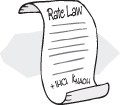3.2.1 Power Law Models and Elementary Rate Laws
The dependence of the reaction rate, –rA, on the concentrations of the species present, fn(Cj), is almost without exception determined by experimental observation. Although the functional dependence on concentration may be postulated from theory, experiments are necessary to confirm the proposed form. One of the most common general forms of this dependence is the power law model. Here the rate law is the product of concentrations of the individual reacting species, each of which is raised to a power, for example,
![]()

The exponents of the concentrations in Equation (3-3) lead to the concept of reaction order. The order of a reaction refers to the powers to which the concentrations are raised in the kinetic rate law.1 In Equation (3-3), the reaction is α order with respect to reactant A, and β order with respect to reactant B. The overall order of the reaction, n, is
n = α + β
The units of –rA are always in terms of concentration per unit time, while the units of the specific reaction rate, kA, will vary with the order of the reaction. Consider a reaction involving only one reactant, such as
A → Products
with an overall reaction order n. The units of the specific reaction rate constant are
![]()
Consequently, the rate laws corresponding to a zero-, first-, second-, and third-order reaction, together with typical units for the corresponding rate constants, are:




An elementary reaction is one that involves a single step, such as the bimolecular reaction between an oxygen free radical and methanol molecule
O• + CH3OH → CH3O• + OH•
The stoichiometric coefficients in this reaction are identical to the powers in the rate law. Consequently, the rate law for the disappearance of molecular oxygen is
–rO• = kCO• CCH3OH
The reaction is first order in oxygen free radical and first order in methanol; therefore, we say that both the reaction and the rate law are elementary. This form of the rate law can be derived from Collision Theory, as shown in the Professional Reference Shelf 3A on the DVD-ROM. There are many reactions where the stoichiometric coefficients in the reaction are identical to the reaction orders, but the reactions are not elementary, owing to such things as pathways involving active intermediates and series reactions. For these reactions that are not elementary but whose stoichiometric coefficients are identical to the reaction orders in the rate law, we say the reaction follows an elementary rate law. For example, the oxidation reaction of nitric oxide discussed earlier,
2NO + O2 → 2NO2

is not really an elementary reaction, but follows an elementary rate law; therefore,
![]()
Another nonelementary reaction that follows an elementary rate law is the gas-phase reaction between hydrogen and iodine
H2 + I2 → 2HI
with
–rH2 = kH2CH2CI2
In summary, for many reactions involving multiple steps and pathways, the powers in the rate laws surprisingly agree with the stoichiometric coefficients. Consequently, to facilitate describing this class of reactions, we say that a reaction follows an elementary rate law when the reaction orders are identical with the stoichiometric coefficients of the reacting species for the reaction as written. It is important to remember that the rate laws are determined by experimental observation! Chapter 7 describes how these and other rate laws can be developed from experimental data. They are a function of the reaction chemistry and not the type of reactor in which the reactions occur. Table 3-1 gives examples of rate laws for a number of reactions. By saying a reaction follows an elementary rate law as written, gives us a quick way to look at the reaction stoichiometry and then write the mathematical form of the rate law. The values of specific reaction rates for these and a number of other reactions can be found in the Data Base found on the DVD-ROM and on the Web.
The rate constants and the reaction orders for a large number of gas- and liquid-phase reactions can be found in the National Bureau of Standards’ circulars and supplements.2 Also consult the journals listed at the end of Chapter 1.
We note in Table 3-1 that Reaction Number 3 in the First-order Rate Laws and Reaction Number 1 in the Second-order Rate Laws do not follow elementary reaction rate laws. We know this because the reaction orders are not the same as the stoichiometric coefficients for the reactions as they are written.
Table 3-1. Examples of Reaction Rate Laws

